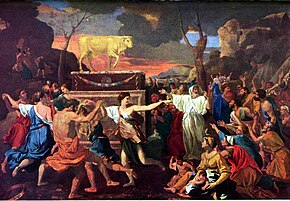Idolatry
From Wikipedia, the free encyclopedia
|
|
This article needs additional citations for verification. Please help improve this article by adding citations to reliable sources. Unsourced material may be challenged and removed. (October 2009) |
Behaviour considered idolatrous or potentially idolatrous may include the creation of any type of image of the deity, or of other figures of religious significance such as prophets, saints, and clergy, the creation of images of any person or animal at all, and the use of religious symbols, or secular ones. In addition, theologians have extended the concept to include giving undue importance to aspects of religion other than God, or to non-religious aspects of life in general, with no involvement of images specifically. For example, the Catechism of the Catholic Church states: "Idolatry not only refers to false pagan worship. Man commits idolatry whenever he honours and reveres a creature in place of God, whether this be gods or demons (for example satanism), power, pleasure, race, ancestors, the state, money etc." [3]
The avoidance of the use of images for religious reasons is called aniconism, which has been an aspect of all major religions at times, some much more consistently than others. The destruction of religious images within a culture is called iconoclasm, of which there have been many major episodes in history.


No comments:
Post a Comment